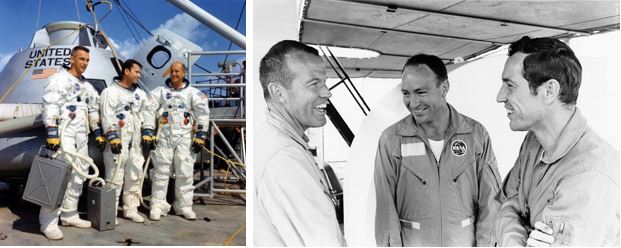On November 13, 1968, NASA announced the crew for the Apollo 10 mission, scheduled for the spring of 1969. Apollo 10 was planned as the fourth crewed Apollo mission, the third to use the Saturn V Moon rocket to launch astronauts, and the second crewed flight of the Lunar Module (LM). Possible scenarios for Apollo 10 ranged from an Earth orbital flight to a lunar orbit mission, depending on the success of the preceding two missions.
The prime crew consisted of Commander Thomas P. Stafford, Command Module Pilot (CMP) John W. Young, and Lunar Module Pilot (LMP) Eugene A. Cernan. All three were experienced astronauts, each having flown at least one Gemini mission, and as a team had served as the backup crew for Apollo 7. The Apollo 10 backup crew of Commander L. Gordon Cooper, CMP Donn F. Eisele and LMP Edgar D. Mitchell, would be ready to fly the mission in case something happened to the prime crew. Cooper had flown one Mercury and one Gemini mission, Eisele flew as the CMP on Apollo 7, with Mitchell being the only rookie on the crew.
The Apollo 10 astronauts were training for a lunar orbit mission to test all three components of the Apollo spacecraft, the Command and Service Modules and the LM. But if an earlier Apollo mission needed to be repeated the crew would be prepared to accomplish those tasks. In an optimal scenario, the crew would essentially carry out a dress rehearsal of a lunar landing mission, including independent flight of the LM in lunar orbit down to about 50,000 feet above the Moon’s surface. Apollo 10 would take the nation one step closer to accomplishing the goal of landing a man on the Moon and returning him safely to the Earth.

training as the Apollo 7 backup crew in August 1968. Right: Apollo 10 backup crew (left to right) Gordon Cooper,
Edgar Mitchell, and Donn Eisele shown during water egress training in April 1969.
Read Apollo 10 Commander Stafford’s oral history with the JSC History Office.
Astronaut biographies can be found at https://www.nasa.gov/humans-in-space/astronauts/

























